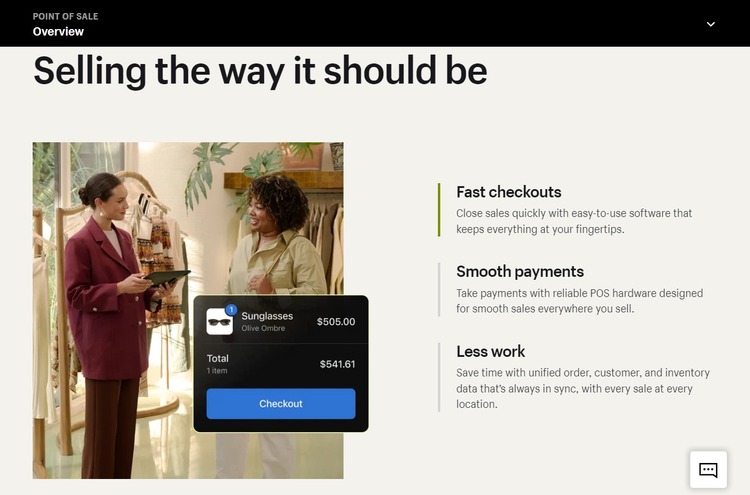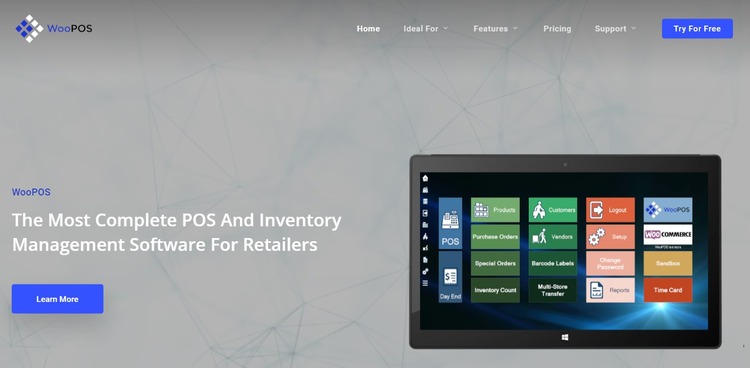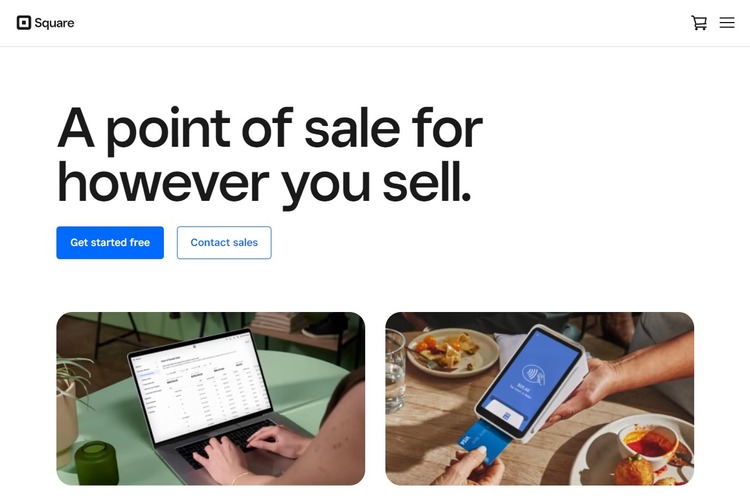Top 5 Shopify POS Integrations: Which POS Works Best With Shopify?
Shopify POS integrations will play a vital role in the success of brick-and-mortar businesses looking to expand their operations with Shopify as their preferred eCommerce platform.
Key Takeaways
- Popular POS systems such as SquarePOS, Vend, WooPOS, and Clover POS can integrate with the Shopify ecommerce platform. However, they may come with certain limitations or restrictions.
- Shopify POS is the best choice to integrate with Shopify ecommerce. Shopify offers a comprehensive solution to synchronize the 2 systems, providing centralized management, inventory, reporting, enhanced customer experience, and flexible order fulfillment options.
What Is A Shopify POS Integration?
A Shopify Point of Sale (POS) integration is a digital solution that establishes a seamless connection between your Shopify eCommerce and POS system. This integration enables you to retrieve comprehensive real-time data of products, pricing, inventory, sales, and customer information directly between the two systems, facilitating the processing of transactions and orders across both online and offline channels.
How Does It Work?

In general, Shopify POS - eCommerce integration encompasses the automated execution of retail operations and the exchange of information between brick-and-mortar and online channels. It involves:
- Synchronizing catalogs between physical and online stores
- Automatically updating inventory for both in-person and online sales
- Transferring inventory data, orders, and order fulfillment across the two channels
- Providing a centralized solution for processing transactions, both online and offline, and supporting various payment methods.
Top 5 POS Systems That Work Seamlessly With Shopify
Shopify POS: Best For Shopify

Shopify POS is a point-of-sale solution developed by Shopify and is one of the robust point-of-sale tools to help merchants effectively sell almost anywhere, including brick-and-mortar stores, markets, and pop-up shops.
Shopify POS is obviously the best choice to go with Shopify ecommerce. When you use Shopify POS, you can rest assured that integration and data synchronization between your online and offline stores are seamlessly managed. This integration offers numerous advantages, which will be discussed below. See our detailed review of Shopify POS for more information.
Vend (also known as Lightspeed X Series): Best For Inventory Management

Vend is a browser-based platform POS system designed for retail businesses of all sizes. Vend’s integration with Shopify provides a straightforward solution for retailers to sell both in-store and online. You can start without the need for coding, ensuring a hassle-free and stress-free setup.
The integration enhances efficiency and optimizes profits by effectively managing inventory across various locations and channels. It grants you access to a real-time overview of sales performance, allowing you to gain valuable insights into which products are selling and their respective locations. Additionally, Shopify and Vend simplify the management of your customer database, enabling you to serve shoppers regardless of their location or preferred buying method.
WooPOS: Best For Customizations

Designed to enhance the functionality of the default admin web interface, WooPOS introduces exciting new features, automates routine tasks, and simplifies day-to-day operations. It is a user-friendly Windows application that can be easily installed without requiring any special skills, allowing you to focus on your core business tasks.
When integrated with your Shopify online store, WooPOS can serve as a comprehensive Shopify store manager, offering a centralized point of control for inventory management and reporting across multiple physical stores.
SquarePOS: Best for businesses on a budget

Square Point of Sale is a popular choice among small businesses and entrepreneurs. It offers a free plan, a user-friendly interface, and robust features such as inventory management, payment processing, and sales analytics.
The Square POS - Shopify integration allows for instant synchronization of product, inventory, and image data. This connection ensures comprehensive store management across all channels, increasing exposure and sales potential. With flexible reporting options, you can optimize sales opportunities by tracking the effectiveness of advertising, customer mailings, promotions, and discounts.
There is no native integration between Square and Shopify. However, you can connect Square POS to Shopify through third-party apps like SkuIQ or Zapier.
Clover POS: Best for restaurants

The Clover is a user-friendly point-of-sale system used by many small and midsized businesses of many types: restaurants, retail outlets, or professional services.
Clover is integrated with Shopify for two main purposes. Firstly, it lets you establish an online presence and allows customers to place orders online or make reservations through your Shopify store. Secondly, the integration between Clover and Shopify is beneficial for order fulfillment. In fact, Shopify serves as the back-office system where you can efficiently manage all your orders. This includes tracking incoming orders, processing payments, updating tables and menus, and handling shipping logistics.
Clover has a wide variety of hardware options, including POS stations with customer-facing displays and a mini station with a built-in card reader. Its Flex handheld POS system stands out in particular for its versatility. It can be used to take payments and orders in-line, at customers’ tables, or in a different location.
There are a number of apps that can integrate your shopify website and Clover pos. Some popular options include Patchworks, Kosmos, and SkuIQ.
Limitations When Integrating POS From Different Platform With Shopify?
When you integrate between different platforms, either your ecommerce platform or POS system serves as the primary system of record, functioning as the core system for managing your business operations. It can lead to inefficiencies, as data may not be promptly or comprehensively shared between the two systems, resulting in a fragmented and inaccurate picture of your business. You may need to manually reconcile inventory and sales at the end of each day.
When you use an API to connect a POS system and an ecommerce platform built by different providers, some inventory or order fulfillment features can be missing, creating a messy customer experience.
The refresh rate of a third-party API may not be fast enough to ensure the synchronization of sales and inventory data in real-time as you conduct online sales and transactions at your physical store. Inaccuracies in inventory levels or sales data may happen, which pose a higher for high-volume stores or when running promotions.
Third-party API may require updates each time your ecommerce platform or POS system is updated by your provider. Delays between these updates can lead to a disrupted connection, causing a breakdown in the processing flow.
Furthermore, integrating POS and ecommerce systems from different platforms can result in additional costs, particularly when considering the expense of third-party APIs required to link the two systems. These costs should be taken into account when assessing the overall impact on your business’s budget.
To streamline your business management and minimize these drawbacks, we recommend using an integrated POS system - a system developed by the same company that provides your ecommerce platform. An integrated POS system like Shopify POS provides a unified system of record where both online and in-store data converge, updating in real-time from a single source.
With Shopify, you gain access to a comprehensive set of tools that liberate you from traditional sales counters, allowing you to sell wherever your customers are with all the necessary resources to cater to the diverse shopping preferences of your customers.
Start free trial now
Why Should You Choose Shopify POS To Work With Shopify?
Based on research conducted by Harvard Business Review, customers who have done prior research on a brand’s website regarding products they’re interested in, typically end up spending 13% more in physical stores. This means that customers with a good omnichannel experience with your brand will likely spend more in your retail stores.
Therefore, it’s important to have a seamless and unified shopping experience on both online and offline channels to successfully serve your customers and meet their expectations. Here are some reasons you should consider having your POS and Ecommerce integration with Shopify:
Manage Online And Offline Stores From An Unified Platform
With Shopify, you can run your eCommerce website and retail stores seamlessly within a single system, eliminating the need for integration. Your Shopify site and Shopify POS communicate with each other effectively, enabling the sharing of product information, order details, inventory status, sales data, and customer information.
This synchronization also ensures reliable inventory data, as stock levels are continuously updated in real-time, maintaining harmony between online and in-person sales. With that, you will eliminate the risk of overselling products online that are not available in stock.
In addition, the Shopify admin serves as the centralized back office for your online and physical stores. You can add products, set prices, fulfill orders, manage inventory, view customer purchase history, and perform various other administrative tasks through the admin interface.
This tightly knit connection eliminates manual data entry, minimizes errors, and reduces your precious time and effort so you can focus on your business.
Leverage Centralized Reporting And Analytics

Since Shopify helps you manage online and offline stores within the same system, its comprehensive reports offer a unified perspective of your brand’s overall performance.
You can effortlessly monitor inventory levels across each store location, analyze revenue generated per sales channel, identify product performance, and gain insights into items thriving or struggling on shelves.
These valuable reporting features empower you with the information to make informed decisions and optimize your business operations effectively.
Enhance Customer Experience

When Shopify POS and the online store integrate seamlessly, they provide a comprehensive set of features for order fulfillment and omnichannel selling that can significantly benefit your business.
Effective retention marketing campaign
Shopify unifies customer profiles for both ecommerce and retail, eliminating the need to export transaction data from separate systems. This unified platform allows you to track customers’ personal information, order history, and shopping preferences, enabling you to create targeted email campaigns that increase customer relationships.
Store staff can effectively engage with hesitant in-store shoppers by sending them email carts containing the products they showed interest in. You can also send promotional emails to customers or notify them when previously unavailable products are restocked, ensuring they stay updated and have the opportunity to make a purchase.
This level of communication helps to engage customers, drive repeat purchases, and enhance their overall shopping experience.
Additionally, one of the most notable benefits of a synced Shopify POS and ecommerce is that customers can get one-to-one service from the staff at a retail store, and staff have the information they need to offer personalized service at their fingertips.
For example, staff can look up a shopper’s purchase history to ensure the products they recommend align with their tastes and preferences. If the shopper has a preferred color, retail staff can add a note to the customer’s profile to share context with any store associate who serves them in the future.
This will strengthen the bond with customers and improve customer engagement.
Flexible order fulfillment

Modern consumers desire the freedom to shop to their preferences. Retailers must establish a customer-centric buying journey to meet customer expectations and foster brand loyalty.
If an in-store shopper desires a size or color that is currently unavailable, there is no need to lose the sale entirely. With Shopify POS - eCommerce integration, it is not restricted to selling only the products currently in stock at your store, and you have the ability to check inventory availability at other locations and fulfill purchases by shipping them from your warehouse or another store with the desired stock.
You can facilitate exchanges and returns at any store location for items purchased online or from any other location. Furthermore, you can offer the option of “buy online pick up in-store,” meaning that customers can choose to collect their orders at a location of their preference.
Shopify’s unified POS - ecommerce system helps you unify all selling channels and lets shoppers buy and receive products however convenient.
Cross-channel customer rewards
With Shopify, you can launch a unified rewards program across your online platform and physical stores. It allows you to reward customers for their purchases, whether made online or in-store, and enables them to redeem their rewards at their preferred shopping location.
This cross-channel reward ensures that customers can enjoy the benefits of their loyalty and encourages them to continue shopping with your brand.
How To Integrate A POS System With Shopify?
While the specific steps for integrating a POS system with Shopify may vary depending on the POS system you choose, there are some fundamental steps that you should follow during the process:
- Step 1: Check if your POS system or your POS plan is compatible with the Shopify integration
- Step 2: Take a back-up of any product data before you begin.
- Step 3: From your POS admin, find the Connect to Shopify button.
- Step 4: Input your Shopify domain. If you’re not already logged in to your Shopify store, you’ll be asked to enter your Shopify log in credentials.
- Step 5: Set up your products. You can choose to link your products from both systems or import all products from your POS to Shopify.
- Step 6: Configure the Shopify integration
- Step 7: Test the integration to make sure it works as intended.
Shopify POS Integrations: FAQs
If you’re a start-up, there are several steps you can take to establish a smooth and efficient connection between your POS system and eCommerce platform:
Conduct research to identify an all-in-one solution that seamlessly integrates both the POS system and eCommerce platform, enabling a seamless connection between the two channels.
Look for a POS system that offers a robust eCommerce platform, such as Shopify POS. Within the Shopify’s ecosystem, you will have a powerful POS system to open retail stores and a website for an online presence. You can also reach out to the Shopify Expert marketplace for valuable expertise, guidance, and necessary support from professionals for everything you need to run a successful business.
No. You have to create a Shopify store to integrate the POS system you’re using with Shopify.
To integrate your POS to Shopify, we recommend reaching out to your POS provider to ask about the options they offer. Sometimes, you may have the only option to activate the built-in eCommerce service provided by your POS solution.
After gathering all the necessary information, you can make an informed decision about whether to continue with your current POS provider to integrate with your Shopify, or explore alternatives and potentially switch to another POS system that better meets your integration requirements.
Bottom Line
Here are the top five Shopify POS integrations for your Shopify store. Integrating these tools with Shopify offers substantial benefits and advantages for your POS business.





